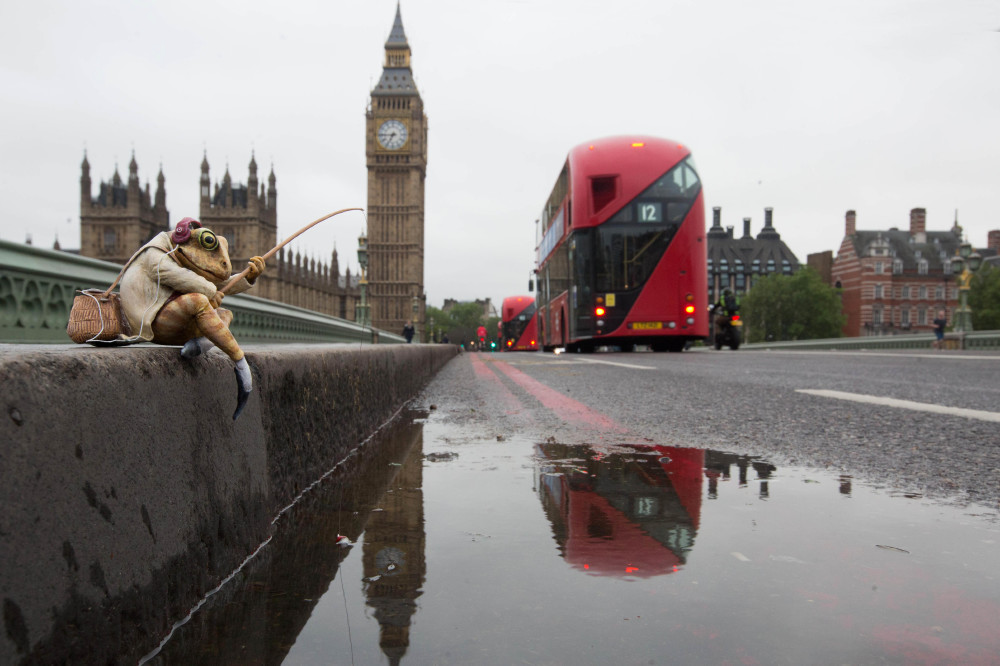Six miniature sculptures of Beatrix Potter characters, updated for the 21st century, have been unveiled in locations across London in celebration of the 150th anniversary of the author's birth. They were created by renowned street artist Marcus Crocker and captured on film at sites including the Southbank, Westminster Bridge, St. James' Park and Bond Street. We caught up with Marcus to talk about his inspiration behind the project and why Beatrix Potter is just as popular now as she was when her books were first released.

Marcus Crocker
What inspired you to update the Beatrix Potter characters for the modern day?
- The project was commissioned by Penguin Random House, who wanted to celebrate Beatrix's 150th anniversary by creating modern interpretations of her best-loved characters. The challenge with this was making sure I developed engaging and surprising depictions of how her characters could have evolved whilst also staying true to the essence of their original personalities. I remember sitting in a coffee shop in Soho one afternoon sketching out some ideas for Peter Rabbit when I looked out the window and saw some tourists using a selfie stick. That's when the main idea for Peter's adventures around in London hit me and the other ideas flowed from there.

Can you tell us a little bit about the process of making the tiny tributes?
- The process has quite a few stages for these sculptures. After brainstorming and finalizing the ideas for each character, I'd start off with lots of research- re-reading the books and searching through hundreds of images online showing the animals from different angles to get a basic understanding of their anatomy.
The creation of the actual sculpture starts with building a wire armature to get the basic structure. Then we build up the main body with layers of air-drying clay and glue to make it stronger. I let each layer dry before continuing, which allows me to build in lots of fine detail. I need to make sure each character looked anatomically correct before adding the layers of clay for those characters wearing clothes. Then I paint these with acrylic paint, finishing off with highlights and shading to make the colours stand out in the photographs.
The most important part of the whole process was finding a good location to place and photograph sculptures as this is ultimately what people are going to see.

How big a fan of Beatrix Potter were you as a kid?
- I grew up reading Beatrix's stories. We had the entire collection and my parents loved the books as children too. My family had an old Victorian house that had a small garden with a fence at the bottom. I would climb the fence into the huge garden behind. It had a massive vegetable plot, kept beautifully by a lovely gentleman who was a Spitfire pilot in WWII. For many years, I thought he was Mr. McGregor and my mother only helped fuel that belief.

Why do you think her stories have stood the test of time and still popular with kids and adults today?
-Beatrix Potter's characters and stories are completely timeless. The human and relatable aspects of her characters are beautifully observed. Despite appearing relatively simple stories they are actually very clever, humorous and engaging reads and can therefore appeal to both younger and older generations in different ways.

To what extent do you think her stories were ahead of her time like she was?
- The fact that her stories have not only endured the test of time but thrived from it is testament to Beatrix's amazing mind and accomplishments.

Why is it important to consider how our favourite characters might have evolved if they were dropped into a different period in time?
- I think it's a lot of fun to see how they may have evolved and helps us to appreciate how the technological advances help our lives to become easier and more connected with those around us. However, in many ways I think it's important to illustrate how a lot of the changes of time are aesthetic and external - the environment around us may have changed but the essence of these characters and their spirit still endures.

Why was understanding the anatomy of each animal so important to you?
- Firstly an appreciation and understanding of the anatomy of animals was something that was also important to Beatrix. You get the sense in her illustrations that she really understood how these animals moved, lived and breathed, which is perhaps what gave such life to her characters.
I felt in order to do the sculpture of each character justice I needed to have an understanding of their anatomy too so they would look plausible and accurate in the final sculptures. I'd always keep images and the books in front of me for reference when sculpting and painting.

What is next for you?
- I'll definitely carry on doing these sculptures as I've met so many interesting people along the way since I started doing them. I've always enjoyed and been good at writing and poetry as well so I'd love to follow Beatrix's footsteps in writing and illustrating a children's story of my own one day!
The figures will go on display at Waterstones Piccadilly for the month of July. To find out more about Beatrix Potter visit peterrabbit.com.
To find out more about Marcus Crocker visit marcuscrocker.com
Tagged in Beatrix Potter

